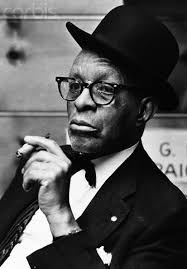
Willie “The Lion” Smith was a founding father of Harlem Stride piano that combined elements of ragtime, barrelhouse, and classical concert piano technique in his style. Along with friendly rivals James P. Johnson and Thomas “Fats” Waller, Smith’s virtuosity had tremendous influence on future jazz pianists including Duke Ellington, Count Basie and Thelonious Monk. In Ellington’s own words, “No one could ever play the same again after hearing The Lion.” Ellington, as an homage to Smith ,would later write “Portrait of The Lion”.
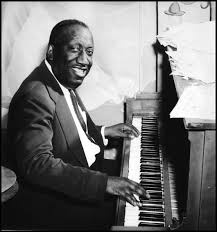 James Johnson
James Johnson 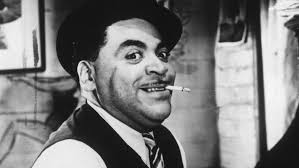 Fats Waller
Fats Waller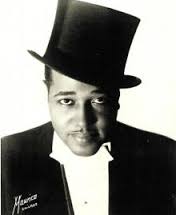 Ellington
Ellington
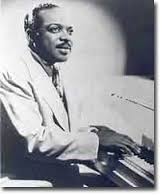 Basie
Basie 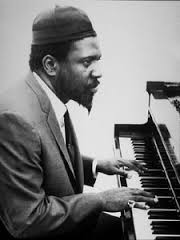 Monk
Monk
Although he was a braggart and (with his cigar and trademark derby hat) appeared to be a rough character, Smith was actually more colorful than menacing and a very sophisticated pianist with a light touch.
He’s been called a musician’s musician, whose original approach made him the envy of virtually every pianist in jazz — and every wise guy. “The Lion” was as well known for his flamboyant behavior, ever present cigar and derby hat as he was for his Harlem stride style piano.
According to Smith, his birth father was Jewish. As a boy, he delivered clean clothes to his mother’s clients, including to a prosperous Jewish family who invited him to sit in on Hebrew lessons on Saturday mornings. Willie was bar-mitzvahed in Newark at age thirteen, and later in life worked as the cantor for a Black Jewish congregation in Harlem.William Henry Joseph Berthol Bonaparte Bertholoff was born in Goshen, New York on November 23rd, 1897. According to Smith’s autobiography, his mother Ida had “Spanish, Negro, and Mohawk Indian blood,” and his birth father, Frank Bertholoff, was a “light-skinned playboy who loved his liquor, girls, and gambling.” By age two, Ida had thrown Frank out of the house, and she relocated to Newark, New Jersey, where she worked as a laundress and the boy took the surname of her new husband, John Smith, a master mechanic.
By age six he began learning to play the piano from his mother, herself an accomplished church pianist and organist. Smith proved a quick study, and by 1911 he began playing professionally in Newark. Newark and the nearby city of Jersey City, home to James P. Johnson, served as excellent training ground for the generation of African-American pianists who would later be known as the founders of the Stride piano style. While growing up in Newark, he was exposed to music of both Jewish and African American cultures and would later embrace these influences in his own sound.

Smith first met Johnson while performing at Randolph’s club in Newark. Smith was the steady pianist for the club at the time and Johnson, along with his future wife, Lillie Mae Wright, came to Randolph’s angling for work. Lillie Mae got the job, but Johnson was informed that the club already had a pianist. It is through Lillie Mae that Willie “The Lion” Smith and James P. Johnson were introduced. From that day in 1914, according to Smith, a bond formed between the two, and “Jimmy and I, we became like twins and came up together.”
Smith worked consistently in Newark and the Harlem and San Juan Hill areas of Manhattan until 1917, when the United States became involved in World War I. orated the rhythmic stride style in his playing.
In 1916, Willie enlisted in the Army where he became the drum major for his unit. During World War I, he spent over a month on the front lines, where he earned his name “The Lion” for his bravery. Later, Smith enlisted with the all-black 92nd Division and served active duty in France as a gunner on the front line. Smith was heralded for his bravery in battle after volunteering to fire the “Glorious 75,” an enormous French-made cannon, and was given the nickname “The Lion” by his commanding officer for his heroism.
Discharged from the army in 1919, Smith returned to New York City and picked up his position as one of the finest pianists, or “ticklers” as they were known, in the city. The consummate showman, he was notorious for his fine clothes and his carefully maintained image. “A good image is good for the mind and soul”, Smith said, “It gives a man the dignity to conduct his affairs in a proper manner.” According to James P. Johnson, “when Willie Smith walked into a place, every move was a picture.”
The Lion quickly became a mentor for younger musicians such as Duke Ellington, Bix Beiderbecke, Artie Shaw, and the Dorsey Brothers. They would often go up to Harlem and listen to Willie and play and ask for musical tips to better their skills.
As the 1920s arrived, a new form of jazz piano playing emerged out of Harlem — stride. An evolution from ragtime, stride had a true master in Willie Smith. Also during this time, many Harlem “rent parties” started; residents would invite friends over and serve up food, drinks and live music, charging a nominal fee in order to raise money for rent. Some of Willie’s piano contemporaries were Johnson, Fats Waller, and Eubie Blake. While playing at rent parties, members of this group would often engage in friendly musical combat called “cutting contests.” Each pianist would try to top the other — both on the keyboard and off.
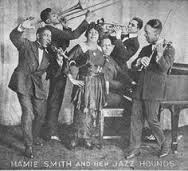 Willie with Mamie Smith & the Jazz Hounds
Willie with Mamie Smith & the Jazz Hounds
Smith held a steady gig at Leroy’s in Harlem from his return from France through 1920. On August 10th, 1920 Willie put together and performed with the band that supported Mamie Smith (no relation) on the groundbreaking recording of ’Crazy Blues’ for Okeh records. ‘Crazy Blues,’ often cited as the first recording of a blues tune, sold more than a million copies in the first year it was released and started a national craze for blues acts. While Willie’s playing is barely audible behind Mamie Smith’s powerful vocal and the horn section, there are a few moments, particularly following the line “I can read his letters but I just can’t read his mind” where one gets a tiny taste of Smith’s already masterful Stride styling.
Though he recorded infrequently through the decade, as a performer Smith was constantly in demand throughout the twenties. Smith continued to be a fixture of the Harlem scene, either as a leader, solo act, or as a sideman working with Sidney Bechet, Bubber Miley, Jimmy Harrison, Johnny Hodges and Benny Carter. By the early thirties Smith held a standing engagement at the Pod and Jerry’s club on 133rd St. in Harlem.
While already a legend in New York, Smith did not become a national figure until 1935 when he released a number of small group recordings on Decca records. On May 14th, 1934 Willie Smith made his first solo recording, “Fingerbuster.” This fairly incredible display of keyboard facility might not quite out-class James P. Johnson’s or Art Tatum’s finest efforts but clearly displays an incredibly creative musical mind coupled with brilliant technique. The strength of his left hand is especially well demonstrated throughout the recording. The influence of Stride and Classical piano is clear in this composition.
Willie always brought his interest in European classical music into his playing and composing. His own compositions were inventive and always challenging. During the 1930s, he composed a number of beautiful pieces, some of which infused a classical feeling, such as his most famous composition “Echo of Spring.”
Smith made a number of small group and solo recordings during the second half of the 1930s but it was a session for Commodore on January 10th, 1939 that is, perhaps, the finest example of his genius. The session yielded such gems as “Passionette,” “Echoes of Spring,” and another mind boggling version of “Fingerbuster.” Of these, “Echoes of Spring” stands out as a beautiful, classically impressionistic composition tinged with just the right amount of stride style. Smith executes the piece brilliantly on this recording.
Smith’s fame continued to grow steadily through the forties. He again performed and recorded with Sidney Bechet and had his compositions performed by two of the most popular bandleaders of the day, Artie Shaw and Tommy Dorsey. Smith remained a constant force in the New York clubs and would frequently engage in piano ‘battles’ with James P. Johnson. At the end of the decade Smith toured Europe and North Africa. “The Lion” was incredibly well received on both continents, a clear sign that his reputation was now international.
Willie “The Lion” Smith lived through six decades of music and, despite the changes in musical styles over those years, he remained true to himself and his own style.
Smith’s popularity would not diminish in the following decades. He continued to play regularly in New York and Toronto and was a major draw at festivals around the U.S. and Europe. In 1965 Smith published his memoirs, “Music on My Mind: The Memoirs of an American Pianist” and released his first solo album in seven years. Smith never showed any signs of slowing down. He performed just a few short months before he passed away at the Village Gate in New York as a part of concert called ‘Piano Evolution’, a clear tribute to his contribution to the idiom. Smith passed away April 18th, 1973 in New York, the city he had called home for most of his life.
Willie “The Lion” Smith lived long enough to be considered a walking legend. In his later years he received frequent honors for his life’s work including a “Willie ‘the Lion’ Smith Day” in Newark, New Jersey. Perhaps the greatest evidence of “The Lion’s” greatness was the words of praise and respect he received from his peers.

One thought on “Which Stride Piano Player was also a Trained Cantor in a NYC Synagogue?”